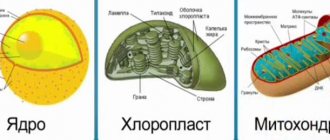Genetic information and its implementation in the cell. - presentation
Genetic information and its implementation in the cell
Lecture plan 1) Genetic information 2) Matrix principle 3) Genetic role of nucleic acids 4) Central dogma of molecular biology 7) Replication Reparation 9) Underreplication of the ends of linear molecules. Telomerase. 10) Application of DNA amplification technologies
9) Underreplication of the ends of linear molecules. Telomerase. 10) Application of DNA amplification technologies
Information about the structure of proteins encoded using the nucleotide sequence of DNA and RNA. All information about the structure and activity of cells and the organism as a whole. Genetic information morphological structure development metabolism mental makeup, behavioral characteristics predisposition to diseases genetic defects of the body Genetic information determines gender
Matrix principle Information carrier - an exact copy is reproduced according to the template.
( ) Nikolai Konstantinovich Koltsov was the first to formulate the idea of matrix synthesis. The protein chromosome is basically a molecule or bundles of molecules with a linear arrangement of genes in them
Evidence of the genetic role of DNA In 1928, F. Griffith discovered the principle of transformation in the pneumococcus Streptococcus pneumoniae. Frederick Griffith ( )
Evidence for the genetic role of DNA 1943 O. Avery, K. McLeod and M. McCarthy showed that the substance causing transformation in Griffith's experiment was destroyed by DNase, but not by RNase or proteases.
Evidence of the genetic role of DNA Experiment by A. Hershey and M. Chase in 1952 on bacteriophage T2
1953 - James Watson and Francis Crick Discovery of the DNA double helix
The central dogma of molecular biology The rule was formulated by Francis Crick in 1958
DNA REPLICATION The universal biological process of transmitting genetic information across generations of cells and organisms through the creation of identical copies of DNA. DNA The genetic material encoded in DNA is duplicated and divided between daughter cells
Enzymatic DNA synthesis 1956 Arthur Kornberg isolated the enzyme DNA polymerase Arthur Kornberg ( ) Lehman, IR, Bessman, MJ, Simms, ES, and Kornberg, A. (1958). Enzymatic synthesis of deoxyribonucleic acid. I. Preparation of substrates and partial purification of an enzyme from Escherichia coli. J Biol. Chem. 233, Bessman MJ, Lehman IR, Simms ES, Kornberg A (1958). Enzymatic synthesis of deoxyribonucleic acid. II. General properties of the reaction. J Biol. Chem. 233, Nobel Prize in Physiology or Medicine 1993
Complementarity From Kolman, Rem “Visual Biochemistry”
Meselson and Stahl's experiment, 1958 SEMI-CONSERVATIVENESS
Meselson and Stahl's experiment, 1958
1) bacteria were grown on a medium with 15N 2) transferred to a medium with 14N 3) DNA of each generation was isolated and centrifuged in a CsCl gradient In the first generation: hybrid DNA, in the second - half “light” and half “hybrid” DNA Evidence of a semi-conservative replication mechanism !
Antiparallelism and unipolarity From Kolman, Rem “Visual Biochemistry”
Replicon discontinuity is the distance between two origins of replication ori. In plasmids, prokaryotes, mitochondrial DNA and plastids, the entire circular molecule is one replicon.
Priming requirement a: template strands, b: leading strand, c: lagging strand, d: replication fork, e: RNA primer, f: Okazaki fragment
Trombone Model Peter J. Russell, iGenetics: Copyright © Pearson Education, Inc., publishing as Benjamin Cummings.
E. coli replication proteins DNA ligases are enzymes that cross-link DNA strands. During replication, ligases stitch together the chains of Okazaki DNA fragments. Helicases are enzymes that unwind the double-stranded DNA helix, consuming energy from the hydrolysis of NTP triphosphates. SSB proteins - maintain DNA strands in a single-stranded state Primase - synthesizes RNA primer (primer) RNaseH - removes RNA primer DNA polymerase I - fills gaps between segments of the lagging strand DNA polymerase III - key enzyme for the replication of chromosomal DNA in E. coli
Principles of replication 1. Complementarity 2. Antiparallelism 3. Semi-conservativeness 4. Unipolarity 5. Discontinuity 6. Need for priming
DNA polymerase III is the main replication enzyme. Properties of DNA polymerase: 1. Attaches one nucleotide from the 3rd end of the growing chain. 2. Requires a paired 3 end to start working. 3. Clips one nucleotide back if it is not paired – i.e. corrects his mistakes. 3'3′
3->5 exonuclease activity (editing)
DNA replication speed Prokaryotes – 1000 nucleotides/sec Eukaryotes – 100 nucleotides/sec
Mutations and repair systems DNA polymerase error rate ~ 10 – – 10 Nucleotide insertion errors ~ 10 – – 5 Editing function of DNA polymerase ~ 10 – – 8 Post-replicative mismatch repair system ~ 10 – – 10 Mutations are random changes in the nucleotide sequence of a cell’s DNA . They occur as errors in normal cellular processes.
Mutagens Environmental factors that increase the spontaneous frequency of mutations: - Chemical mutagens - El. -magn. radiation (ultraviolet, radiation) - Viruses Spontaneous level of mutations: - Replication errors - Insertion of transposable elements - Cell division errors
Types of damage 1) Modification of nitrogenous bases (alkylation, deamination) 2) Apurinization and apyrimidinization (cleavage of nitrogenous bases) 3) Breakage of the DNA chain (single-stranded or double-stranded) 4) Formation of cross-links between the bases of the same chain or different chains
Repair systems Proteins that correct errors and damage to DNA. Prokaryotes: three enzyme systems: direct, excision and post-replicative. Eukaryotes: more Miss-match and Sos-repair
Mechanisms of DNA repair 1) Direct repair Photolyase
Mechanisms of DNA repair 2) Excision repair 2a) Base excision - the damaged base is removed by glycosylase and replaced by an intact one 2b) Excision of 2-20 nucleotides followed by chain restoration
Repair of double-strand breaks 1) End joining 2) Homologous repair Mazin et al., (2010)
Telomeres and telomerase The problem of underreplication of linear DNA ends – A.M. Olovnikov, 1971 New chains are shortened at 5 ends - where the RNA primer is eaten away, and DNA polymerase cannot complete construction without a paired end. With each division, the chromosome loses 50 bp. at the ends - telomeres.
Telomerase is an enzyme that builds up the ends of chromosomes. contains RNA. elongation occurs by reverse transcription Elizabeth H. Blackburn – received the Nobel Prize in 2009 for the discovery of telomerase
Telomerase
In vitro DNA amplification. Polymerase chain reaction.
Invention of PCR Carrie Mullis (born d) Nobel Prize in Chemistry 1993 Article in Science magazine, 1985:
Application of PCR Forensics Establishment of paternity Medical diagnostics. Personalized medicine Gene cloning Sequencing Mutagenesis Ancient DNA
Isothermal amplification PHI 29, in addition to DNA polymerase activity, has helicase activity
Literature
Genetic code, grade 10 presentation for a biology lesson (grade 10)
Slide 1
Genetic information and its implementation in a cell Biology lesson in 10th grade
Slide 2
Genetic information. DNA doubling
Slide 3
Structure of DNA DNA consists of two polynucleotide chains. Each chain is twisted into a spiral to the right, and both chains are twisted together to form a double helix. The helix pitch is 3.4 nm (10 base pairs per turn), and the turn diameter is 2 nm. Phosphate groups are located on the outside of the helix, and nitrogenous bases are on the inside.
Slide 4
Structure of DNA By joining each other with a phosphodiester bond (the 3′-phosphate group of one nucleotide and the 5′-sugar group of another nucleotide), two nucleotides form a dinucleotide. During the synthesis of polynucleotides, this process is repeated millions of times.
Slide 5
Genetic information Genetic information is information contained in DNA molecules. A gene is a section of a DNA molecule that encodes information about the amino acid sequence of one protein. Genome is the totality of all DNA sections of a haploid set of chromosomes.
Slide 6
DNA replication Genetic information is recorded at the molecular level and protein synthesis occurs according to the matrix principle. Replication is a process of template DNA synthesis carried out by the enzyme DNA polymerase. Koltsov Nikolai Konstantinovich
Slide 7
The meaning of DNA replication Reproduction of genetic information during the reproduction of living organisms. Transfer of hereditary properties from generation to generation. Development of a multicellular organism from a zygote.
Slide 8
Genetic code Protein biosynthesis. Transcription and broadcast
Slide 9
The implementation of genetic information in a cell DNA carries information about the structure of all proteins in the body. m RNA or mRNA - carries information about the primary structure of the protein (it is an intermediary between the cell nucleus, where the information is stored, and the cytoplasm, where the protein molecule is assembled). DNA mRNA PROTEIN
Slide 10
Genetic code The genetic code is a set of rules according to which in living cells the nucleotide sequence of mRNA is translated into the sequence of amino acids in protein. Marshall Nirenberg, who began deciphering the genetic code, 1961 – 1968
Slide 11
Properties of the genetic code Triplety - 1 amino acid is encoded by a sequence of 3 nucleotides. Nucleotides – 4 Amino acids – 20 4 1 = 4 4 2 = 16 4 3 = 64 4 4 = 256 little for 20 a/k excessive
Slide 12
Properties of the genetic code Triplety Unambiguity - each triplet encodes only one specific amino acid. Between genes there are punctuation marks - stop codons. There are no punctuation marks inside genes. The code is universal for all living organisms on Earth.
Lesson 15. What is the genetic code: general information
Methodological development of lessons for grades 10-11
Lesson type -
combined
Methods:
partially search, problem presentation, explanatory and illustrative.
Target:
— formation in students of a holistic system of knowledge about living nature, its systemic organization and evolution;
-the ability to give a reasoned assessment of new information on biological issues;
- education of civic responsibility, independence, initiative
Tasks:
Educational
: about biological systems (cell, organism, species, ecosystem); history of the development of modern ideas about living nature; outstanding discoveries in biological science; the role of biological science in the formation of the modern natural science picture of the world; methods of scientific knowledge;
Development
creative abilities in the process of studying the outstanding achievements of biology that have entered into universal human culture; complex and contradictory ways of developing modern scientific views, ideas, theories, concepts, various hypotheses (about the essence and origin of life, man) in the course of working with various sources of information;
Upbringing
conviction in the possibility of knowing living nature, the need to take care of the natural environment, and one’s own health; respect for the opponent's opinion when discussing biological problems
UUD
Personal results of studying biology
:
1. education of Russian civic identity: patriotism, love and respect for the Fatherland, a sense of pride in one’s Motherland; awareness of one's ethnicity; assimilation of humanistic and traditional values of multinational Russian society; fostering a sense of responsibility and duty to the Motherland;
2. the formation of a responsible attitude towards learning, the readiness and ability of students for self-development and self-education based on motivation for learning and knowledge, conscious choice and construction of a further individual educational trajectory based on orientation in the world of professions and professional preferences, taking into account sustainable cognitive interests;
Meta-subject results of teaching biology:
1. the ability to independently determine the goals of one’s learning, set and formulate new goals for oneself in learning and cognitive activity, develop the motives and interests of one’s cognitive activity;
2. mastery of the components of research and project activities, including the ability to see a problem, pose questions, put forward hypotheses;
3. ability to work with different sources of biological information: find biological information in various sources (textbook text, popular scientific literature, biological dictionaries and reference books), analyze and
evaluate information;
Cognitive
: identification of essential features of biological objects and processes; providing evidence (argumentation) of the relationship between humans and mammals; relationships between humans and the environment; dependence of human health on the state of the environment; the need to protect the environment; mastering the methods of biological science: observation and description of biological objects and processes; setting up biological experiments and explaining their results.
Regulatory:
the ability to independently plan ways to achieve goals, including alternative ones, to consciously choose the most effective ways to solve educational and cognitive problems; the ability to organize educational cooperation and joint activities with the teacher and peers; work individually and in a group: find a common solution and resolve conflicts based on coordinating positions and taking into account interests; formation and development of competence in the field of use of information and communication technologies (hereinafter referred to as ICT competences).
Communicative:
the formation of communicative competence in communication and cooperation with peers, understanding the characteristics of gender socialization in adolescence, socially useful, educational, research, creative and other types of activities.
Technologies:
Health conservation, problem-based, developmental education, group activities
Techniques:
analysis, synthesis, inference, translation of information from one type to another, generalization.
During the classes
What is a genetic code: general information
Tasks
Continue the formation of knowledge about the informational role of nucleic acids in the cell, revealing the structural features of RNA molecules;
Characterize the types of RNA: transport, informational, the structure of these molecules and functions in the cell.
To achieve “understanding and assimilation by students of the essence of the genetic code, its properties: specificity / universality; deepen knowledge about RNA molecules.
Basic provisions
The most important event of prebiological evolution is the emergence of the genetic code in the form of a sequence of RNA codons, and then DNA, which turned out to be capable of storing information about the most successful combinations of amino acids in protein molecules.
The appearance of the first cellular forms marked the beginning of biological evolution, the initial stages of which were characterized by the appearance of eukaryotic organisms, the sexual process and the emergence of the first multicellular organisms.
RNA, just like DNA, is a polymer whose monomer is nucleotides, but instead of thymine, RNA contains uracil, and together with deoxyribose, ribose.
RNA carries information about the sequence of amino acids in proteins, i.e., about the structure of proteins, from chromosomes to their place and participates in protein synthesis.” There are several types of single-stranded RNA. Their names are based on their job or location.
Each amino acid in a polypeptide bud corresponds to a combination of three nucleotides - a triplet.
Draw students' attention to the structural features of viral RNA molecules, emphasize their double-stranded nature in contrast to the single-stranded nature of eukaryotic cells
1. Structural features of ribonucleic acids
2.Localization of nucleic acids in the cell
3. Participation of RNA in the implementation of genetic information
4.Genetic code
5. Code redundancy
6. Code specificity
In any cell and organism, all anatomical, morphological and functional features are determined by the structure of the proteins that comprise them. The hereditary property of the body is the ability to synthesize certain proteins. In a DNA molecule, amino acids are located in a polypeptide chain, on which biological characteristics depend. Each cell has its own sequence of nucleotides in the polynucleotide chain of DNA. This is the genetic code of DNA. Through it, information about the synthesis of certain proteins is recorded.
A little history
The idea that there might be a genetic code was formulated by J. Gamow and A. Down in the mid-twentieth century. They described that the nucleotide sequence responsible for the synthesis of a particular amino acid contains at least three units. Later they proved the exact number of three nucleotides (this is a unit of genetic code), which was called a triplet or codon. There are sixty-four nucleotides in total, because the acid molecule where protein or RNA synthesis occurs consists of residues of four different nucleotides. —
What is genetic code
The method of encoding the sequence of amino acid proteins due to the sequence of nucleotides is characteristic of all living cells and organisms. This is what the genetic code is. There are four nucleotides in DNA: adenine - A; guanine - G; cytosine - C; timin - T. They are denoted by capital letters in Latin or (in Russian-language literature) in Russian. RNA also contains four nucleotides, but one of them differs from DNA: adenine - A; guanine - G; cytosine - C; uracil - U. All nucleotides are arranged in chains, with a double helix in DNA and a single helix in RNA. Proteins are built on twenty amino acids, where they, located in a certain sequence, determine its biological properties.
Properties of the genetic code.
Tripletity. A unit of genetic code consists of three letters, it is triplet. This means that the twenty amino acids that exist are encoded by three specific nucleotides called codons or trilpets. There are sixty-four combinations that can be created from four nucleotides. This amount is more than enough to encode twenty amino acids. Degeneracy. Each amino acid corresponds to more than one codon, with the exception of methionine and tryptophan. Unambiguity. One codon codes for one amino acid. For example, in a healthy human gene with hemoglobin beta target information, a triplet of GAG and GAA encodes glutamic acid. And everyone who has sickle cell anemia has one nucleotide replaced. Collinearity. The sequence of amino acids always corresponds to the sequence of nucleotides that the gene contains. The genetic code is continuous and compact, which means that it has no punctuation marks. That is, starting at a certain codon, continuous reading occurs. For example, AUGGGUGTSUUAAUGUG will be read as: AUG, GUG, TSUU, AAU, GUG. But not AUG, UGG and so on or anything else. Versatility. It is the same for absolutely all terrestrial organisms, from humans to fish, fungi and bacteria.
Table
Not all available amino acids are included in the table presented. Hydroxyproline, hydroxylysine, phosphoserine, iodine derivatives of tyrosine, cystine and some others are absent, since they are derivatives of other amino acids encoded by m-RNA and formed after modification of proteins as a result of translation. From the properties of the genetic code it is known that one codon is capable of encoding one amino acid. The exception is the genetic code, which performs additional functions and encodes valine and methionine. The mRNA, being at the beginning of the codon, attaches t-RNA, which carries formylmethione. Upon completion of the synthesis, it is cleaved off and takes the formyl residue with it, transforming into a methionine residue. Thus, the above codons are the initiators of the synthesis of the polypeptide chain. If they are not at the beginning, then they are no different from the others. —
Genetic information
This concept means a program of properties that is passed down from ancestors. It is embedded in heredity as a genetic code. The genetic code of RNA (ribonucleic acids) is realized during protein synthesis: messenger RNA; transport tRNA; ribosomal rRNA. Information is transmitted through direct communication (DNA-RNA-protein) and reverse communication (medium-protein-DNA). Organisms can receive, store, transmit it and use it most effectively. Passed on by inheritance, information determines the development of a particular organism. But due to interaction with the environment, the reaction of the latter is distorted, due to which evolution and development occur. In this way, new information is introduced into the body. —
The calculation of the laws of molecular biology and the discovery of the genetic code illustrated the need to combine genetics with Darwin's theory, on the basis of which a synthetic theory of evolution emerged - non-classical biology. Darwin's heredity, variation and natural selection are complemented by genetically determined selection. Evolution is realized at the genetic level through random mutations and the inheritance of the most valuable traits that are most adapted to the environment.
Decoding the human code
In the nineties, the Human Genome Project was launched, as a result of which genome fragments containing 99.99% of human genes were discovered in the two thousandths. Fragments that are not involved in protein synthesis and are not encoded remain unknown. Their role remains unknown for now.
Last discovered in 2006, chromosome 1 is the longest in the genome
. More than three hundred and fifty diseases, including cancer, appear as a result of disorders and mutations in it. The role of such studies cannot be overestimated. When they discovered what the genetic code is, it became known according to what patterns development occurs, how the morphological structure, psyche, predisposition to certain diseases, metabolism and defects of individuals are formed.
Issues for discussion
What is the hereditary material of some viruses that do not contain DNA? How do they implement hereditary information?
What are the properties of the genetic code?
What are the ways of transmitting hereditary information in biological systems?
What is the essence of the process of transferring hereditary information from generation to generation and from the nucleus to the cytoplasm, to the place of protein synthesis?
Genetic
code . Transcription
Genes ,
DNA and chromosomes
What
are genes ?
Unified State Exam
in Biology . Genetic Code
Resources
V. B. ZAKHAROV, S. G. MAMONTOV, N. I. SONIN, E. T. ZAKHAROVA TEXTBOOK “BIOLOGY” FOR GENERAL EDUCATIONAL INSTITUTIONS (grades 10-11).
A. P. Plekhov Biology with fundamentals of ecology. Series “Textbooks for universities. Special literature".
Book for teachers Sivoglazov V.I., Sukhova T.S. Kozlova T. A. Biology: general patterns.
https://fb.ru/article/198930/chto-takoe-geneticheskiy-kod-obschie-svedeniyaFB.ru:
School world INFO https://www.shkolnymir.info/content/view/95/9
Nature of the world
https://natworld.info/novosti/babochki-mogut-byt-starshe-cvetov-na-desjatki-millionov-let
FB.ru
https://fb.ru/article/198783/hvostatyie-zemnovodnyie-samyie-yarkie-predstaviteli etogo-otryada
Biolessons
https://biouroki.ru/material/lab/2.html
YouTube website
: https://www.youtube.com/
Presentation hosting
— https://ppt4web.ru/nachalnaja-shkola/prezentacija-k-uroku-okruzhajushhego-mira-vo-klasse-chto-takoe-ehkonomika.html
Realization of hereditary information. Genetic code (lesson development, presentation)
Lesson objectives:
Educational: students must:
learn and understand:
— the essence and mechanism of implementation of hereditary information ;
- the essence of the genetic code; characteristics of the properties of the genetic code.
- provide evidence of the unity of living nature.
- be able to apply the theoretical material of the topic to solve cytological problems.
- understand the practical significance of the material being studied.
During the classes.
1. Organizing time.
1.1. Greeting from the teacher.
1.2. Checking students' readiness for the lesson.
1.3. Motivation. Interpretation of the meaning of L.N. Tolstoy’s words “Try to give your mind as much food as possible” (Slide 2).
2. Goal setting and planning of student activities.
Teacher's word.
You have technological maps on your tables (Slide 3). Fill in the column of the table “At the beginning of the lesson...” by placing a “+” sign next to those questions that do not cause difficulties for you at this stage of the lesson and a “-” sign next to those questions that cause difficulties.
Students fill out the second column of the table.
1. I know the material on the topic “Chemical composition of the cell”
2. I can give a detailed description of the following biopolymers: proteins and nucleic acids
3. I know what metabolism is, I can characterize the two sides of metabolism
4. I know how and what hereditary information is recorded in a cell
5. I understand the meaning of the concepts “ genetic code ”, “triplet”
6. I can name and characterize the properties of the genetic code
7. I can solve cytological problems using material on the topic “Implementation of hereditary information . Genetic code"
8. I can explain the meaning of the quote by Matt Ridley “The strand of DNA is a letter written using an alphabet of chemical compounds called nucleotides.
One letter – 1 nucleotide. It’s incredibly simple, I can’t even believe that the code of life is written in symbols that we can freely read. It’s amazing how people managed to comprehend the alphabet of life?”
Now, formulate the objectives of the lesson and the plan for our work (Slide 4).
3. Updating students’ knowledge on the topic “Chemical composition of the cell”, “Metabolism and energy conversion”.
In order to understand the new material, establish relationships and provide a holistic picture of the perception of the entire topic, we will repeat a series of questions on the topic “Chemical composition of the cell”, “Metabolism and energy conversion”.
Tasks for students:
1). What substance are we talking about in these chains of words?
- biopolymer, peptide, amino acid, 20, primary, secondary, tertiary, quaternary structures, enzymes, catalase, hemoglobin;
- double helix, hydrogen bond, biopolymer, nucleotide, Watson and Crick, adenine, thymine, cytosine, guanine, deoxyribose (Slide 5).
2) Make a brief description of these substances, extracting information from these chains (Slide 6).
All material is in the archive.





